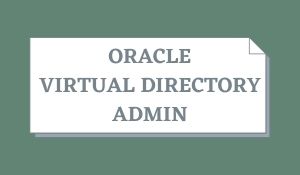
Oracle Virtual Directory in Brief
Oracle Virtual Directory is an LDAP service that provides a single, abstracted view of enterprise directory servers and databases from a variety of vendors. OVD can serve as a single source of truth in an environment with multiple data sources. It presents a unified identification service to applications by aggregating without consolidation. Oracle Virtual Directory minimizes or eliminates the need to change existing infrastructure or applications when you add new ones, saving time and expense. Data translation and joining capabilities allow you to create an integrated view of multiple data sources without changing their structure. This enables organizations to share the data that resides in their own repository while retaining full control of it and monitoring its usage. The sources can be separately owned and need not be synchronized. Users see only a single, logical LDAP tree, although there may be multiple data sources.
OVD helps a variety of clients, such as Web Applications and portals, and it can connect to directories, databases, and Web Services. This permits applications to be deployed more quickly by enabling customers to re-use existing identity stores. And through re-using current identity stores, customers see a greater ROI on existing identity stores as well as reduced compliance costs. Oracle Virtual Directory provides adapters for connecting to a variety of data sources, including Oracle Internet Directory, other directories, and databases.
The benefits of using this version are that Oracle Virtual Directory aggregates identification sources except for consolidation, additionally OVD 11g is the only virtual directory on the market that comes with enterprise-class monitoring and reporting in a default configuration. Customers who wish to take advantage of 11g’s new unified directory service management console, who run OVD clusters and/or want to take advantage of native integration with Enterprise Manager, can get an upgrade to 11g. OVD provides identity aggregation and transformation. It unifies identity data across heterogeneous data sources without consolidating and re-uses identity data without copying. The key new features are:

• Unified Directory services administration via Oracle Directory Services Manager (ODSM)
• Deployment accelerators
• Integration with Enterprise Manager Fusion Middleware Control
• Centralized Fusion Middleware log and auditing
• Unified Identity Management installer
• Automated synchronization of OVD cluster configurations
Latest Advancements on OVD with Various Applications
Oracle Virtual Directory, an identity virtualization service, enables Siebel applications to authenticate and authorize customers from multiple user stores and makes it feasible for LDAP applications to directly access customer identification data in Oracle Customer Hub databases. This combination accelerates Siebel deployment and increases Oracle Customer Hub ROI.
Oracle Virtual Directory approves clients to get the most out of their Siebel & Customer Hub deployments. It reduces the time needed to configure Siebel to use LDAP authentication by offering a single LDAP interface to multiple identity repositories. OVD additionally approves organizations to make their Customer Hub information accessible to LDAP-enabled applications like portals. These applications can then make use of this data for personalization and access control. This reduces complexity by reducing the number of identity stores and will increase the ROI by unlocking the value of the customer data to more corporation applications.
Oracle Virtual Directory (OVD) has enabled Highmark to reduce the time it took to deploy its new access management solution and portal applications. It also enabled Highmark to clean up its identity data without needing to change the existing source systems. They had multiple directories but applications required a single directory service. Additionally, they needed to link attributes from two of the directories to create individual virtual entries, while removing duplicate entries without changing the original data sources. OVD provided the solution. It allowed them to unify their identity data without needing to consolidate and it allowed them to clean their data without changing the original data source. OVD accelerated Highmark application deployment, eliminated additional regulatory certification requirements, and thus provided quick and high ROI.

Oracle Virtual Directory at Gologica
According to Indeed’s latest reports, Oracle Virtual Directory Admin is paid around $115k. Gologica’s Oracle Virtual Directory Admin Online Training is designed to help the learners gain expertise in all the fundamentals and would open up various career opportunities. As the Virtual Directory Admin is one of the most sought after roles in the Oracle industry, Learn at your convenient time and pace. Gain on the job kind of learning experience through industry experts. This online certification would greatly help you in creating a job opportunity.










